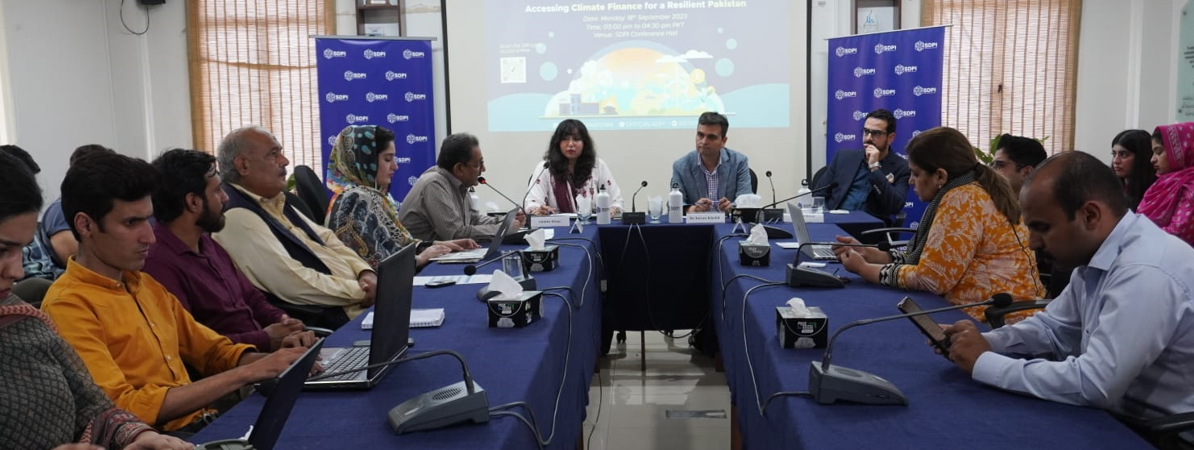
ISLAMABAD, Sep 18 (APP): The experts at a panel discussion intended to highlight financial opportunities available to harness its capacities to address environmental degradation impacts on Monday emphasized the need to explore untapped funding options with clear strategy, planning, and homework for enhancing its climate resilience.
The Sustainable Development Policy Institute (SDPI) organized a panel discussion on “Accessing Climate Finance for a Resilient Pakistan”, its policy paper written by Ahmed Awais Khaver, a research associate and policy expert at the Institute.
Deputy Executive Director, Resilience Development Program & Policy Outreach, SDPI, Shafqat Munir in his opening remarks said the Institute had conducted a series of policy papers on the country’s access to climate finance, disaster risk reduction (DRR), institutional capacity and loss and damage fund.
He said it was beyond that Pakistan was facing climate change, but rather it required adaptation and mitigation efforts to ensure its sustainable future.
When the issues of mitigation and adaptation were discussed it had a price tag that should come from the polluting entities or the country’s bearing the burden of global warming, he added. The panel would be led by Ahmed Awais Khaver the lead author of the policy paper.
Dr Munir underlined that the negative climate financing like investments in solar panels whose waste would be an issue after 25 years also needed to be considered in the major policy discourse.
“Climate change adaptation and DRR need to be linked to get more climate financing to improve the resilience of the country whereas Carbon taxation is an interesting idea and China’s example is worth mentioning which had been implemented for its power companies,” he added.
The policy paper author, Ahmed Khawer briefed the participants on his study document. Explaining the international context of climate finance, he said the adaptation finance had increased from 20-28% from 2017-20 whereas there was stagnated funding provided for both mitigation and adaptation-related projects.
“There has been a little increase in international climate finance as $803 billion have been provided globally for climate finance,” he added.
In Pakistan’s context, he said the 2022 floods alone caused $30 billion in losses $16 billion was required for reconstruction and it required $7-14 billion for annual adaptation purposes.
Pakistan has not utilized climate investment funds (CIFs) and there was space to engage CIFs and bilateral and multilateral funds still available at the global level, he added.
The author suggested that the country also needed to build coherence and alignment in its existing policies, ensure capacity building of technical and human resources, and develop legal and institutional frameworks for public-private partnerships to attract investments at international and domestic levels.
Director of Governance and Policy, WWF-Pakistan, Dr. Imran Saqib Khalid said in order to tap global funding from the Green Climate Fund (GCF) only its accredited entities could proceed with the funding to finance climate change-related projects.
“Only two entities accredited with GCF namely JS Bank and National Rural Support Programme. If you want to bring climate finance you have to go through these entities,” he added.
The WWF-Pakistan applied for GCF funds through WWF-US for the long-awaited Recharge Pakistan, whereas there was no clarity about the processes to tap the funding from GCF, he added.
“Nearly 3% of the total funding goes to adaptation-related projects as mitigation projects are more bankable and attractive,” he noted.
“Bridgetown agenda from Prime Minister of Barbados to move from IMF to more equitable and just financing instruments is interesting and we should look into it and move away from statuesque at the international and country level,” he added.
National Disaster Risk Management Fund (NDRMF), expert on climate finance, Fawad Hayat said there were 28 funds that could provide climate finance to the country that should be approached. However, it was important to consider the country’s capacity to differentiate between development and climate finance.
“We presented seven Nationally Appropriate Mitigation Actions (NAMAs) and all got rejected which indicated that it was a quantitative effort and not a qualitative effort. Climate finance is a serious and continuous effort,” he added.
Hayat said in 2014 Pakistan was among the most prepared countries to access GCF funding that demanded to strengthen enabling environment as the country had complete capacity and knowledge to tap global climate finances whereas it had slowed down over the years.
UNDP’s Operations Analyst Resilience, Environment and Climate Change Unit, Alishba Khan said the country in general and individuals and professionals in particular needed to expand its vision as other than GCF there were many other funding streams available globally.
“It’s time-consuming and laborious to access climate financing through GCF. However, it had introduced a new window to get accredited for a specific project as a test opportunity and allows ten projects to be proposed at a time,” she said.
GiZ climate finance advisor, Anum Rathor said the GCF was the buzzword, whereas people could approach the Global Environment Facility (GEF) and others. The German development organization, GiZ, was working with provincial departments on capacity building in its limited sphere.
Some international development organizations were accredited with GCF but they have their own priority areas that might not conform with the government priorities and to address that there should be nationally accredited entities, she added.